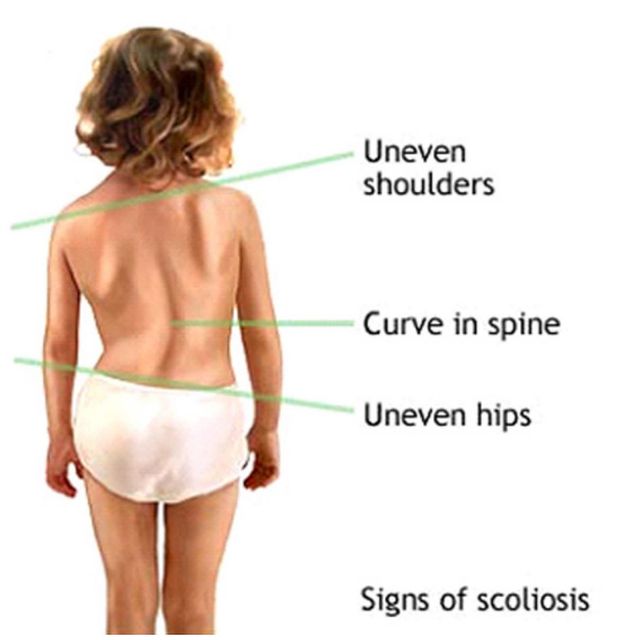by Elise Browning-Miller
When I was 15 years old, I found out that I had scoliosis. My pediatrician examined me one day and saw that when he had me bend forward at the waist, my right back ribs were protruding. He told me I had scoliosis, a lateral curve of the spine with vertebrae that rotated. I was sent to an orthopedic surgeon specializing in scoliosis. He took X-rays of my back that revealed a right thoracic 49-degree curvature with a compensating left lumbar curve. He recommended surgery immediately. If I had surgery, I would be in the hospital for a long period of time and could plan on at least a year’s recovery.
I got a second opinion from a well-known orthopedic surgeon who specialized in scoliosis, Dr. Harris. After Dr. Harris, who was in his sixties, examined me, he told me that my growth spurt had ended and he felt sure that the increase in my curve would subside. He said that too many young surgeons were recommending surgery for too little a degree of curvature and that there was much I could do to stabilize my curve. He recommended that I wait a year, continue to be active in sports, and start swimming regularly with a focus on the backstroke.
But it was the next thing he said to me that changed my life. He told me he had recently read a book on yoga and he believed that its breathing, stretching, and strengthening could be good for those with scoliosis. He was going to research it further, and would examine me again in a year to see if my curve had stabilized.
I look back at that meeting with the late Dr. Harris in 1964 and realize how far ahead of his time he was. This was the diagnosis I wanted to hear, and that small mention of yoga had left an impression that would bring me to yoga years later.
A body with scoliosis develops a highly sophisticated compensating “act” but, with proper instruction, it can also learn a more refined symmetrical “act.” By combining yoga postures with awareness of breath, you can redevelop structural alignment and create more symmetry in the body. By stretching the muscles that have tightened and strengthening the muscles that have become weak from the asymmetrical imbalance of scoliosis, realignment of the body is accomplished. When asymmetry is reduced in spinal alignment, the body can rely more on its bone structure to hold itself up, rather than overworking the muscles, and the effect is a more effortless posture. By developing a regular yoga practice, corrected proprioception and muscle memory come into play, and the muscles begin to move the bones into a more symmetrical, aligned position. In turn, once the bone alignment is improved, the muscles become more efficient and require less effort to maintain that alignment. A regular yoga practice can help you find that balance point that allows the scoliosis curve to coexist with gravity and activates the body’s natural plumb line. The result for most people with scoliosis who commit to a regular yoga practice is better posture and less pain. ~ Elise Browning Miller

Scoliosis facts:
- 80-90% of the population have Functional Scoliosis
- 2-3% of the population have Structural Scoliosis, an estimated 7 – 9 million in the US, or 1/10 persons are structional
- 80% of females get scoliosis vs 20% men
- Females are 8X more likely to progress to a magnitude that needs treatment
- there is no cure for structural scoliosis
- 600,000+ doctor visits/yr for scoliosis
- 30,000+ children/yr are braced
- 38,000+ undergo spinal fusion surgery annually

Muscles affected by scoliosis
- All bilateral muscles in the body
- Intercostal muscles
- Diaphragm
- Erector Spinae muscles
- Latissimus Dorsi
- Trapezius muscle
- Rhomboid muscle
- Quadratus Lumborum muscles
- Iliopsoas muscles
- Full core musculature
The four most common curve patterns are:
- Right thoracic: major curve is in the thoracic spine, the ribs
- Left lumbar: major curve is in the lumbar spine, below the ribcage and above the sacrum
- Right thoracic/left lumbar: combined curve in both regions with opposite sides, “S” curve
- Right thoraco lumbar: one long curve from the lumbar region up into the thoracic region, “C” curve
The Benefits of ScolioYoga & ScolioPilates for Scoliosis
· Consists of a combination of stretching, strengthening, and breathing techniques
· Halt curve progression, eliminate pain, and improve posture—for life!
ScolioYoga
Portions customized from the joint series
Standing poses
Seated poses
Backbends
Twisting poses
Supine and side-bending poses
Inversion
Breath Awareness & increase lung capacity
Restorative
ScolioPilates
Strengthen:
Erector spinae
Core musculature
All bilateral muscles in the body
Intercostal muscles & diaphragm
Lats
Traps
Rhomboids
Full shoulder girdle
Biceps/triceps
Quadratus Lumborum
Iliopsoas
Legs/gluts/hammy’s
pelvic girdle
